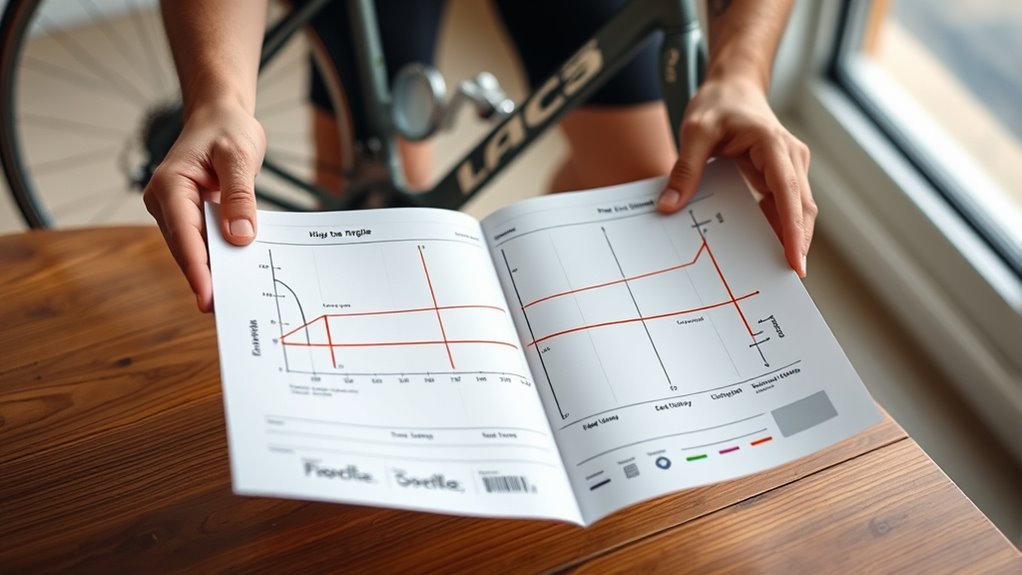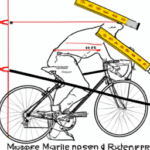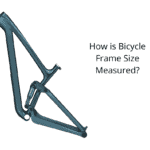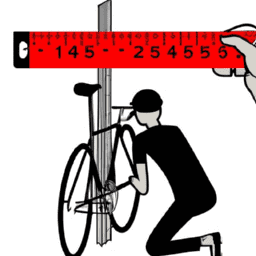To interpret bike geometry charts, start by understanding key measurements like reach and stack, which show how stretched out or tall you’ll feel on the bike. Check head tube angle, fork rake, and trail to see how the bike will steer and handle, especially at speed or on technical terrain. Look at top tube length and wheelbase for fit and stability. Knowing how these dimensions relate helps you choose a bike suited to your riding style—keep exploring for more details.
Key Takeaways
- Identify the key measurements such as reach, stack, head tube angle, and top tube length on the chart.
- Understand how each dimension relates to bike fit, handling, and rider comfort.
- Compare different bike sizes by examining reach and stack to find the best fit for your riding style.
- Look at head tube angle, fork rake, and trail to assess steering responsiveness and stability.
- Use the chart’s visual guides and labels to interpret how frame geometry influences ride characteristics.
Key Measurements in Bike Geometry Charts
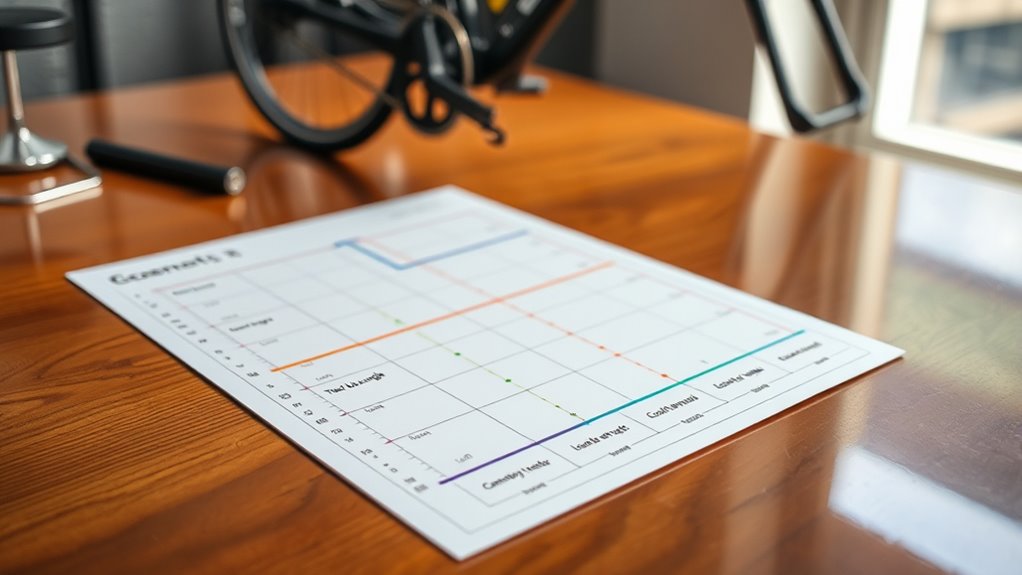
Bike geometry charts showcase essential measurements that define how a bike fits and handles. Key measurements include head tube length, which influences your riding posture and steering responsiveness, and head tube angle, affecting steering precision. Reach and stack are vital for understanding your position on the bike, with reach measuring how stretched out you’ll be and stack indicating your vertical height. The top tube length and effective top tube shape the overall fit, impacting comfort and handling. Understanding bike geometry helps riders choose the right bike for their riding style and comfort. Additionally, knowing how bike measurements relate to riding style can help you optimize performance and comfort. The seat tube angle determines your saddle position and pedaling efficiency. Wheelbase, the distance between axles, affects stability, while chainstay length influences agility. Bottom bracket drop impacts the bike’s center of gravity, contributing to handling and ride quality. Together, these measurements give you a complete picture of how the bike will perform and fit you, and being aware of mechanical failure causes can help maintain optimal bike performance over time. Recognizing ergonomic design principles can further enhance rider comfort and reduce fatigue during long rides.
Understanding Reach and Stack
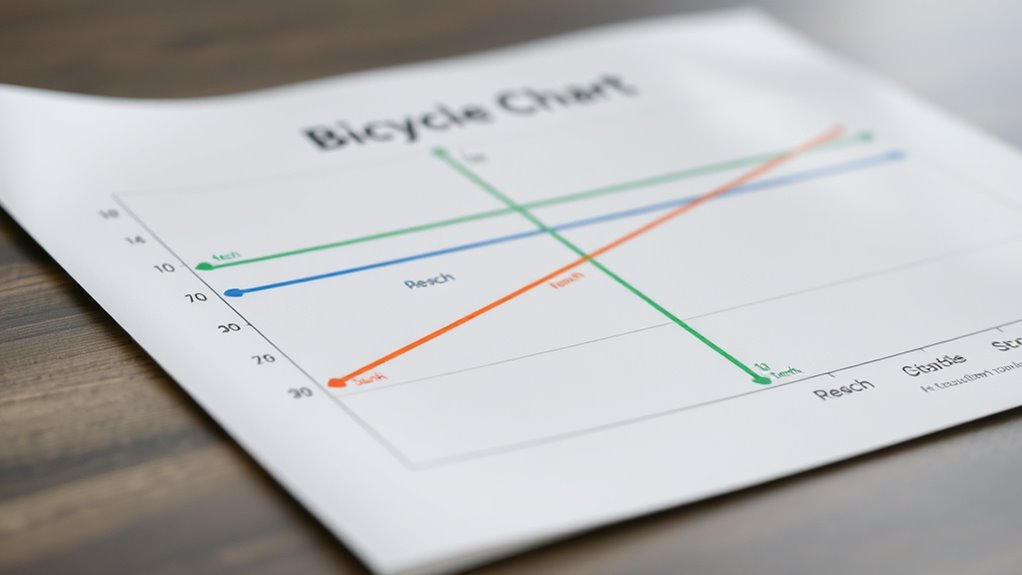
Understanding reach and stack helps you compare bike fit across different models accurately. Reach measures how stretched out you’ll be, while stack shows how upright your position will be. By examining these vertical and horizontal measurements, you can make better cross-brand comparisons and find the best fit for your riding style. Additionally, considering family background insights can provide a more comprehensive understanding of the cultural influences that may shape your preferences. Recognizing the importance of bike geometry can further refine your ability to select a bike that aligns with your riding goals. Being aware of popular juice brands and their health-oriented options can inspire you to choose a balanced diet that supports your active lifestyle. Knowing how to interpret storage indicators can also help ensure your gear and consumables remain safe and effective. Moreover, understanding personality traits can help you select a bike that suits your riding personality and style.
Vertical and Horizontal Measures
Vertical and horizontal measures, known as stack and reach, are essential tools for evaluating a bike’s fit and comfort. Reach is a horizontal measurement from the bottom bracket to the top of the head tube, indicating how far you’ll stretch forward. Stack is a vertical measure from the bottom bracket to the top of the head tube, reflecting the bike’s overall height and your upright position. Both measurements are typically taken with the bike in a level, static position for accuracy. These key measurements span the length of the top tube, the height of the head tube, and the seat tube, enabling you to compare different models and brands regardless of seat tube length. Understanding reach and stack helps you select a bike that aligns with your preferred riding position and comfort. Additionally, high-quality projection technology can enhance your home cinema experience by providing clearer and more vibrant images. To ensure an optimal fit, some manufacturers now provide detailed geometry charts that include these measurements for each model. Accurate interpretation of these charts involves understanding how reach and stack influence your riding style and posture. Recognizing the importance of bike fit measurements can further help you choose the most comfortable and efficient bike setup, especially when considering adjustments and customization options to fine-tune your ride.
Cross-Brand Comparisons
When comparing bikes from different brands, reach and stack measurements serve as essential tools to guarantee a proper fit, regardless of varying size labels or design philosophies. These geometry measurements help you understand how a bike’s frame size affects your riding posture and handlebar position. Cross-brand comparison of reach and stack allows you to find models that offer similar riding positions, even if their overall sizes differ. Since brands often have unique design philosophies, knowing how their geometry charts translate into actual bike fit is vital for accurate comparisons. Using these measurements, you can better assess bike handling and select options that match your preferred riding style and comfort level across various manufacturers. Reach and stack are key to making informed decisions in cross-brand comparisons.
Interpreting Head Tube and Fork Geometry

Understanding the head tube angle and fork rake helps you predict how your bike will handle. A steeper head tube angle makes steering quicker, while a slacker angle offers more stability. By comparing these factors along with trail, you can choose the right setup for your riding style. Additionally, tuning your bike’s geometry can optimize performance for specific terrains and riding preferences. Knowing how modifications like suspension adjustments impact handling can further refine your bike’s responsiveness. Properly adjusting these elements is essential for achieving the desired balance between control and maneuverability.
Head Tube Angle Effects
The head tube angle plays a crucial role in shaping your bike’s handling characteristics. A steeper angle (around 73° to 75°) results in quicker steering and sharper responsiveness, ideal for technical riding. Conversely, a slacker angle (around 68° to 70°) provides greater stability, especially at high speeds. The head tube angle effects are closely tied to trail measurement, which depends on fork rake and offset. Increased trail, often from a slacker head tube angle combined with more fork rake, enhances straight-line stability but can make steering feel heavier. Understanding how head tube angle influences bike geometry helps you choose a setup aligned with your riding style. Whether you prioritize agility or stability, these angles directly impact handling, maneuverability, and overall bike responsiveness. Recognizing the importance of bike geometry can further refine your setup for optimal performance. Additionally, sound vibrations from certain components or environments can subtly influence rider comfort and perception of handling, especially during long rides. Properly tuning fork rake can also optimize trail and handling characteristics to suit your preferences and terrain. Being aware of the personal development principles like continuous learning can also help you better understand complex concepts such as bike geometry, leading to more informed adjustments and improvements.
Fork Rake and Handling
Fork rake, also known as fork offset, is a key factor that influences how your bike handles by affecting the trail and steering response. When you look at a geometry chart, the fork rake measurement in millimeters shows how far the front wheel is offset from the steering axis. A larger fork rake makes handling quicker and more responsive, while a smaller rake results in slower, more stable steering. The head tube angle, combined with fork rake, determines the overall trail, which impacts bike stability and maneuverability. Adjusting the fork rake allows you to customize handling characteristics to suit your riding style. Understanding how fork offset influences handling helps you select or modify your bike for ideal ride quality and performance.
Trail and Bike Stability
Ever wondered how head tube angle and fork rake influence your bike’s stability? They directly affect the trail measurement, which impacts handling and responsiveness. A larger trail—created by a slacker head tube (63° or less) combined with more fork rake—gives you a more stable, planted ride at high speeds. Conversely, a steeper head tube angle (72° or more) with less fork rake results in less trail, making your bike more agile and quicker to respond.
- Imagine a bike with a long, steady glide on straightaways.
- Picture tight, nimble turns with quick steering.
- Visualize how small tweaks in fork rake change trail and handling.
- Think of a geometry chart revealing how these elements balance stability and responsiveness.
Reading Top Tube and Wheelbase Dimensions
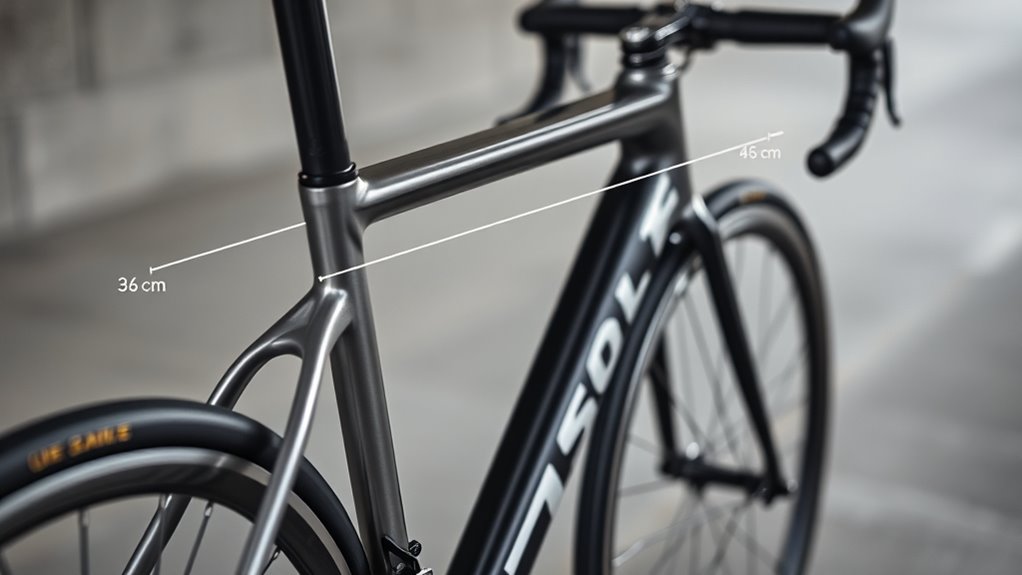
To understand how a bike will fit and handle, start by examining its top tube and wheelbase dimensions on the geometry chart. The top tube length, often listed as effective or horizontal, shows how stretched out you’ll feel and helps compare bike sizes across brands. It influences your frame reach and overall bike fit. The wheelbase measures the distance between the front and rear contact points, which directly impacts handling and stability. A longer wheelbase offers more stability, ideal for smooth rides, while a shorter one allows for quicker maneuvering. By reading the geometry chart carefully, compare the top tube length and wheelbase to predict how the bike will respond to your riding style, ensuring the right fit and performance.
Analyzing Chainstay Length and Wheelbase
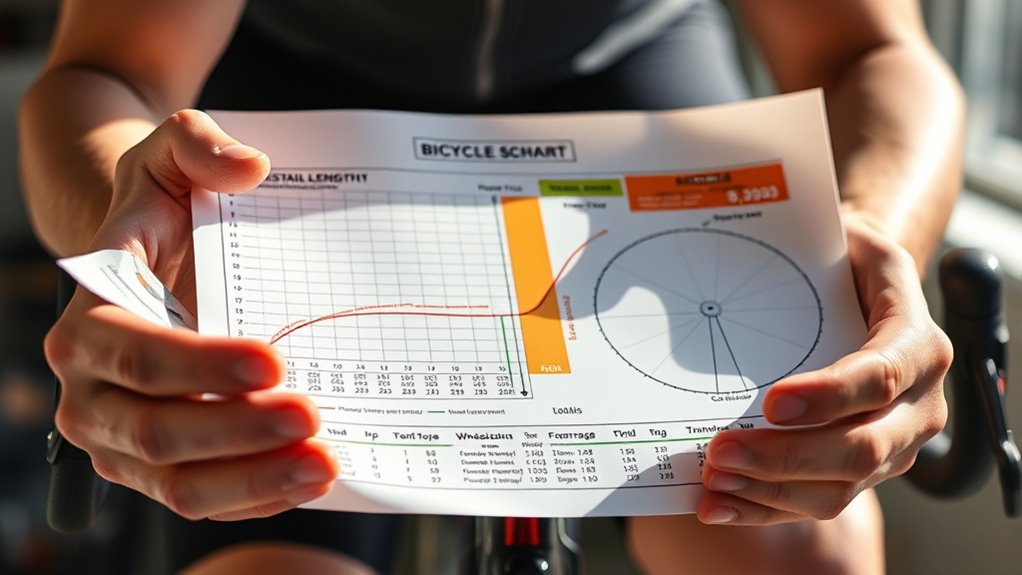
Chainstay length directly influences a bike’s handling and stability by determining its wheelbase. The horizontal measurement from the bottom bracket to the rear dropout affects how the bike responds on the road or trail. A longer chainstay increases the wheelbase, boosting stability and control, especially during descents and high speeds. Conversely, a shorter chainstay, under 410mm, enhances maneuverability, making quick turns and technical riding easier. The wheelbase is the sum of the front center and chainstay length, shaping overall bike handling. Visualize the rear triangle’s shape, the distance from the bottom bracket to the rear dropout, and the front center’s length. These frame geometry details work together to balance stability and responsiveness, guiding your choice based on riding style.
Deciphering Bottom Bracket Height and Drop
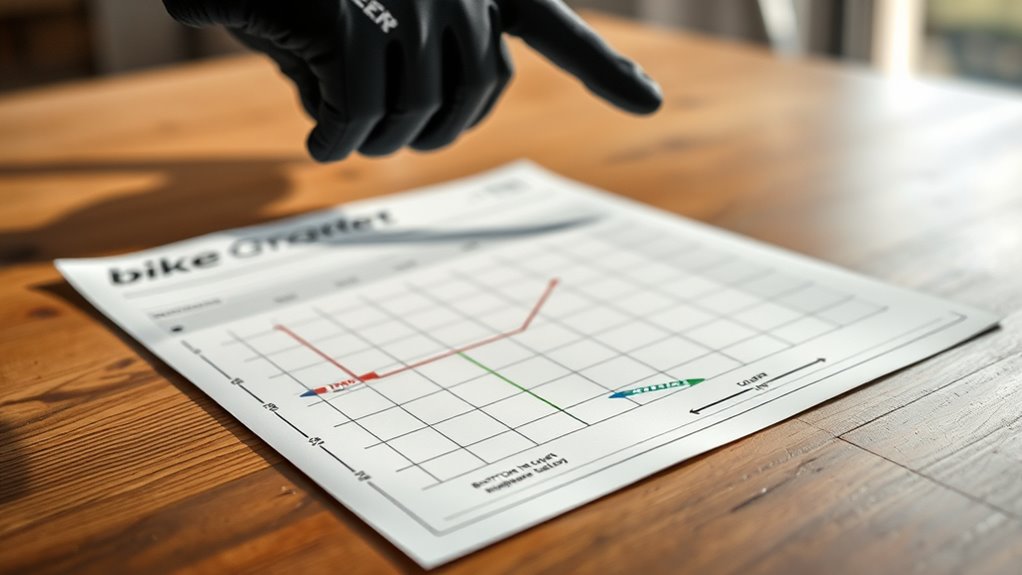
Understanding bottom bracket height and drop is key to grasping how a bike’s geometry influences its performance. Bottom bracket height is the vertical distance from the ground to the center of the bottom bracket, affecting ground clearance and pedal efficiency. Bottom bracket drop measures the vertical distance from an imaginary line between the wheel axles to the bottom bracket, impacting bike stability and handling. A lower bottom bracket drop lowers your center of gravity, which improves cornering stability but reduces ground clearance. Different bike types, like road or mountain bikes, typically have bottom bracket drops from 60mm to 80mm for ideal performance. Changes in tire size or suspension setup can alter these measurements, affecting handling, ground clearance, and overall bike stability.
Additional Components Affecting Fit and Handling
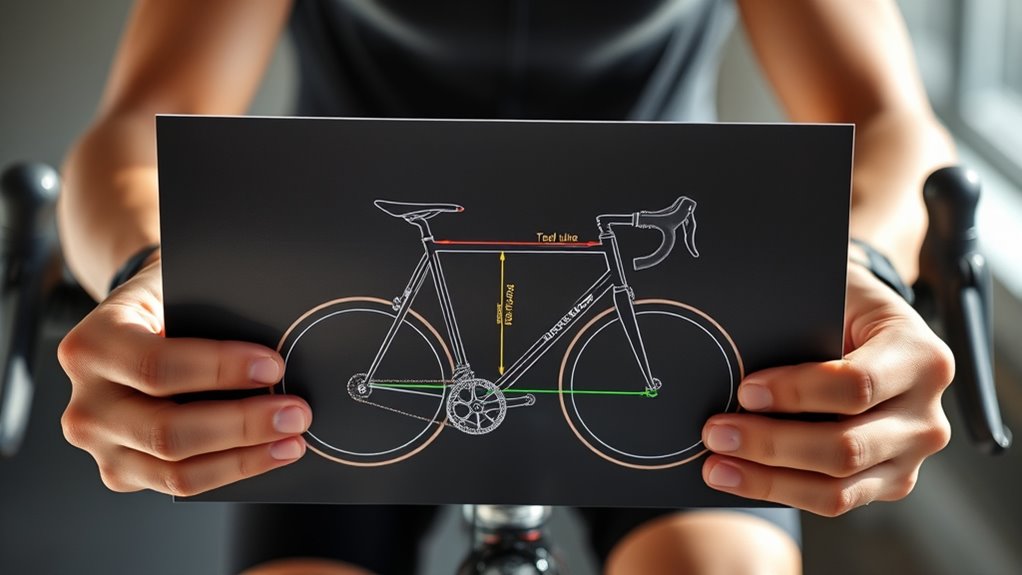
Additional components like handlebar width, stem length and angle, crank arm length, seatpost diameter, and handlebar reach play essential roles in how a bike fits your body and handles on different terrains. Your handlebar width affects control and comfort, while stem length and angle influence reach and steering response. Crank arm length impacts pedaling efficiency, especially for your height and leg length. Seatpost diameter determines saddle height adjustability, and reach affects your riding posture. The stack height and top tube length set your riding position, while the head tube angle influences trail and stability. Visualize:
- Wide handlebar to enhance leverage during climbs
- Short stem for quick, agile steering
- Longer crank arms for more power
- Proper seatpost diameter for comfortable saddle height
Comparing Bike Sizes and Geometry Across Brands

When comparing bike sizes across different brands, relying solely on size labels like small, medium, or large can be misleading, as these categories vary widely between manufacturers. Instead, focus on measurements from the geometry chart, such as top tube length, seat tube length, reach, and stack, for a more accurate size comparison. Different brands may have distinct head tube angles, wheelbase, and handlebar width, which influence ride feel and handling. Two bikes with the same size label can differ considerably in geometry, affecting bike fit and comfort. Cross-referencing these figures helps you understand how each bike will perform and fit your body. Prioritizing actual geometry data over labels ensures a better match for your riding style and preferences across various brands.
Applying Geometry Data to Choose the Right Bike
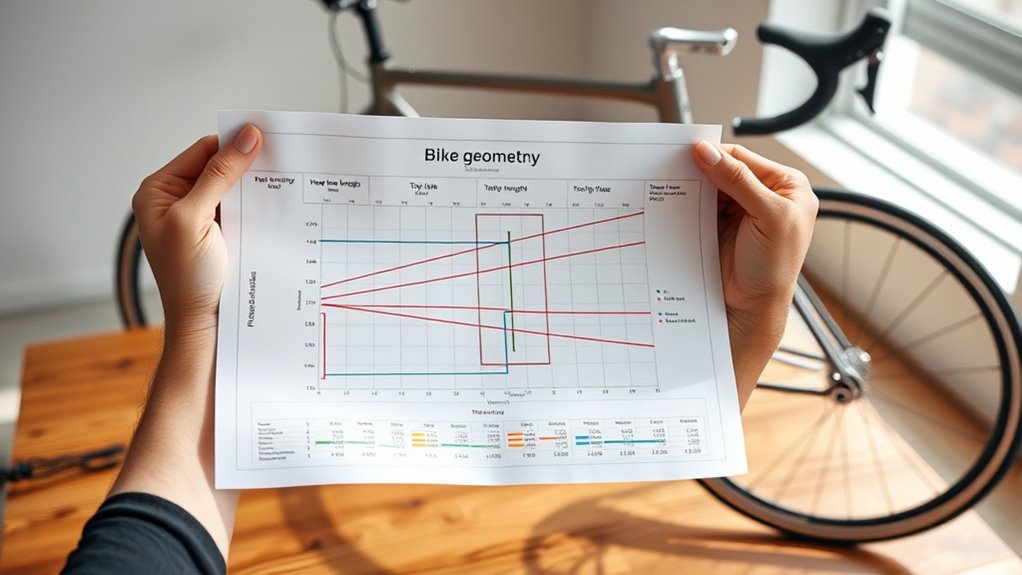
Applying geometry data is essential for choosing a bike that matches your riding style and physical needs. By understanding reach, stack, head tube angle, and wheelbase, you can visualize how the bike will feel under you. Consider how the frame size, top tube length, and seat tube angle support your comfort and efficiency. Analyzing trail and fork rake helps predict steering response and handling characteristics for your terrain. This detailed info guides you to select a bike with the right balance of stability and agility. Imagine:
Understanding bike geometry helps you choose a ride that matches your style and comfort needs.
- A longer reach for racing or endurance riding
- A shorter wheelbase for nimble handling
- A steeper seat tube angle for aggressive pedaling
- A relaxed head tube angle for stability on rough trails
Using these metrics ensures your bike fits perfectly and performs as needed.
Frequently Asked Questions
How Do You Read Bike Measurements?
When you read bike measurements, you look at key numbers like top tube length, head tube length, and wheelbase. These figures tell you about the bike’s size and fit. Pay attention to angles like head tube and seat tube, which affect handling and comfort. Comparing measurements like stack and reach helps you find a bike that matches your riding style and body proportions for a comfortable ride.
How Does Bike Geometry Affect Speed?
Think of bike geometry as the engine tuning of your ride; it directly impacts speed. An aggressive geometry with a longer reach and lower stack positions puts you forward, cutting through air like a sleek arrow. Steeper angles and longer top tubes boost responsiveness, helping you accelerate faster. Shorter wheelbases and trail reduce steering lag, making quick maneuvers effortless. Overall, optimized geometry balances stability and agility, helping you rip through terrain at top speeds.
What Is Aggressive Geometry on a Bike?
Aggressive geometry on a bike means you’re positioned for speed and responsiveness. You’ll notice a longer reach and a lower stack, putting you in a forward-leaning, aerodynamic stance. The head tube angle is steeper, and the top tube is longer, which helps with quick handling and stability at high speeds. This setup is common in race bikes, focusing on performance, power transfer, and aerodynamics rather than comfort or upright riding.
What Does Stack Mean in Bike Geometry?
Imagine your bike telling you how tall or short it wants to feel—that’s what stack does. It measures from the bottom bracket to the top of the head tube, showing how upright or aggressive you’ll sit. A higher stack means a comfy, relaxed ride, while a lower one means you’re ready to race with a more aerodynamic stance. Think of it as your bike’s height secret to perfect riding comfort or speed.
Conclusion
By mastering bike geometry charts, you can confidently select a bike that fits your riding style. For example, if you prefer aggressive downhill riding, understanding the slack head tube angle and longer wheelbase helps you choose a stable, responsive bike. Remember, matching your body measurements and riding goals with the right geometry guarantees comfort, control, and enjoyment on every ride. With this knowledge, you’ll ride smarter and feel more confident on your bike.
